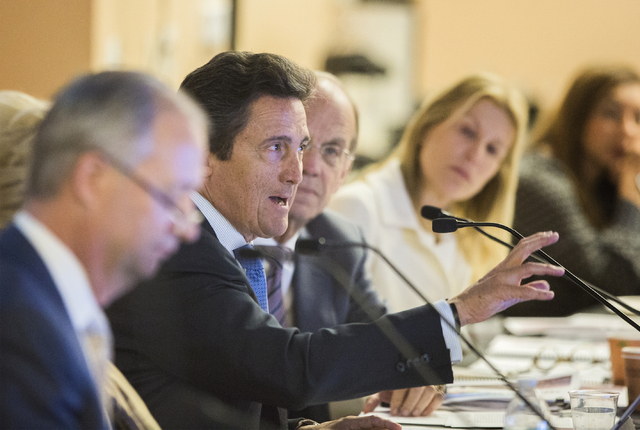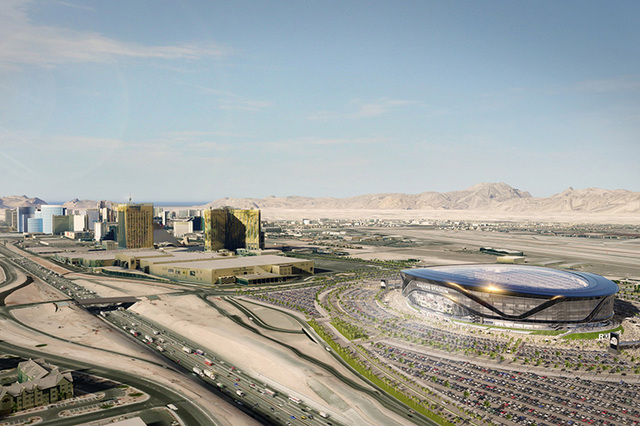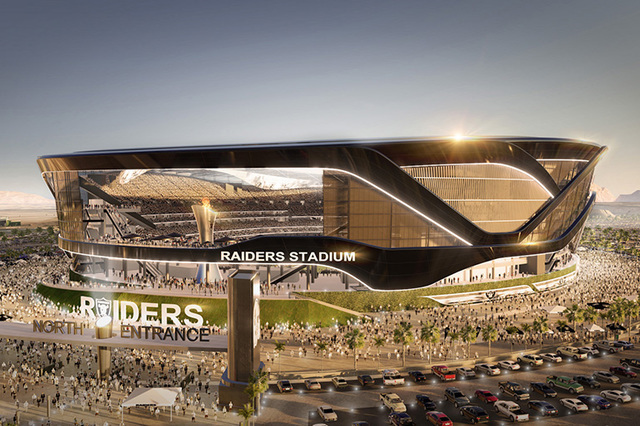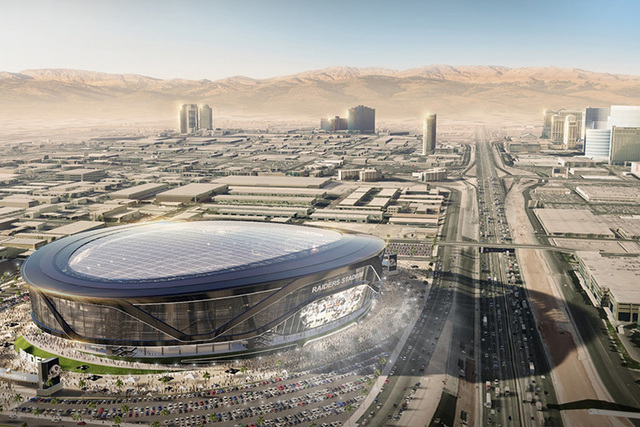MGM’s buy-in was key to Las Vegas stadium project gaining recommendation
I’m not sure Adam Smith would have approved.
You know, given his views about unceasing rivalries being the basis of our market economy.
But this isn’t the late 1700s, and “The Wealth of Nations” didn’t exactly cover the push for state-of-the-art sports stadiums. Sometimes, what many perceive the greater good trumps an inherent hunger for competition.
The greater good part, by the way, is still open for debate.
The Southern Nevada Tourism Infrastructure Committee on Thursday unanimously agreed to recommend financing for a proposed $1.9 billion domed stadium, and perhaps the most surprising moment of the proceedings was which member motioned to approve a public investment of $750 million.
It was Bill Hornbuckle, president of MGM Resorts International. From the project’s inception, MGM had reservations about a deal being led by the family of Las Vegas Sands Corp. Chairman Sheldon Adelson, Majestic Realty and the NFL’s Oakland Raiders.
Hornbuckle also was the person who first suggested Thursday that the committee support the $750 million in room taxes while eliminating a proposed 39 percent public contribution cap.
“With the scale of our company, we had to make sure this was properly vetted,” he said. “We were always encouraged by the idea and notion of it, but it had to be on balance and it had to be the right thing.
“Obviously, less is better than more, but in the overall spectrum of where this came out, what the opportunity is, what the cost is, the balance on governance, on what ultimately needs to be delivered on infrastructure costs, we think it’s ultimately a good bet for the community.”
Those at MGM Resorts never hid their position: While they weren’t totally against using public funds toward the 65,000-seat stadium, they believed plans to expand and renovate the Las Vegas Convention Center took precedent. There was also that underlying issue about MGM Resorts’ privately funded T-Mobile Arena having to compete for events against a stadium that will be publicly funded at such a significant level.
But when the committee voted unanimously in July to recommend the $1.4 billion convention center project, it allowed MGM Resorts to glance directly at the stadium proposal. When it did, the largest employer in the state with the most hotel rooms on the Strip — the company that will delivery most of the room tax revenue allocated for the project — saw it as a unique opportunity.
If you’re on the side of the developer, having MGM Resorts on board is critical.
“Frankly, without their commitment, this would have been very difficult to do,” committee Chairman Steve Hill said. “I’m not even sure it would have gotten done.”
The next step in the stadium journey would be for Gov. Brian Sandoval to call a special session of the Legislature to consider the financing plan. While there is sure to be passionate debate on both sides, MGM Resorts’ backing should only help the developers’ argument.
I don’t believe Sandoval would call the session unless he is convinced there are enough votes to pass. But in case it’s close to reach the necessary two-thirds majority, there are much weaker adversaries to own than MGM Resorts and the influence the company carries.
“I don’t want to predict what would happen with (the Legislature),” Hornbuckle said. “They have the right to do whatever they want, and we respect that. But basically, for a 1.4 percent room tax increase, we can walk away with two substantive projects for Southern Nevada in the (convention center and stadium). That’s very compelling.”
MGM Resorts definitely considered the part about eventually competing with the stadium for events, but smarter heads prevailed when it became obvious, given the difference in size when compared to T-Mobile, how seldom such a face-off could occur.
Translation: If he ever returns to play Las Vegas, Bruce Springsteen will do so in a stadium.
How many musical acts in the world, by the way, can fill 65,000 seats?
Hornbuckle is also correct in saying this isn’t Baltimore or Minnesota, that the uniqueness of Las Vegas and its ability to draw tourism could ultimately combat the overwhelming evidence that stadium projects supported by public financing are never good deals.
Maybe it’s true with this one, too.
Ultimately, the Legislature will decide whether to test such a theory, one supported by an extremely significant party.
“It meant a lot to us that MGM understood,” said Andy Abboud, senior vice president of government relations and community development for Las Vegas Sands. “They have been very cautious about this entire project, but they understood it. I think they understand the kind of impact it can have on their company, as well as everyone along the Strip. It meant a lot to us that Mr. Hornbuckle made the motion, absolutely.”
It wasn’t like the CEO of Coca-Cola being caught drinking Pepsi, but it was notable just the same.
The Review-Journal is owned by the family of Las Vegas Sands Corp. Chairman and CEO Sheldon Adelson.
Ed Graney can be reached at egraney@reviewjournal.com or 702-383-4618. He can be a heard on “Seat and Ed” on Fox Sports 1340 from 2 p.m. to 4 p.m. Monday through Friday. On Twitter: @edgraney
RELATED
Oakland Raiders owner Mark Davis: 'Everybody wins' in Las Vegas stadium vote
Giunchigliani places stadium plan on Tuesday County Commission agenda
Southwest critical of Bali Hai site for proposed stadium
Gov. Sandoval calls for clarity on proposed stadium's road infrastructure costs




















